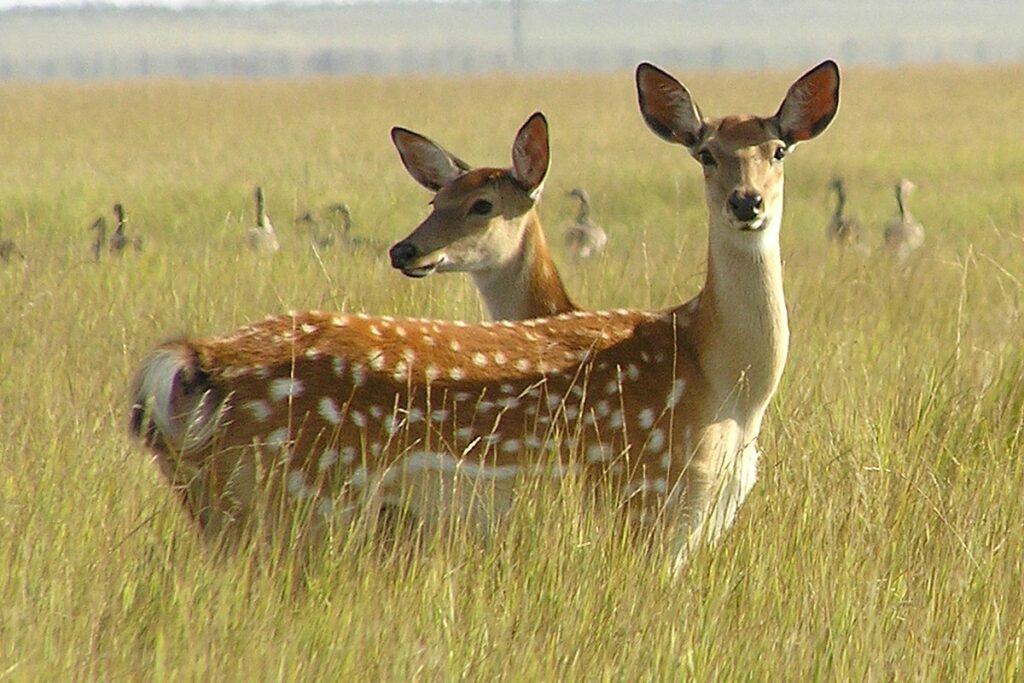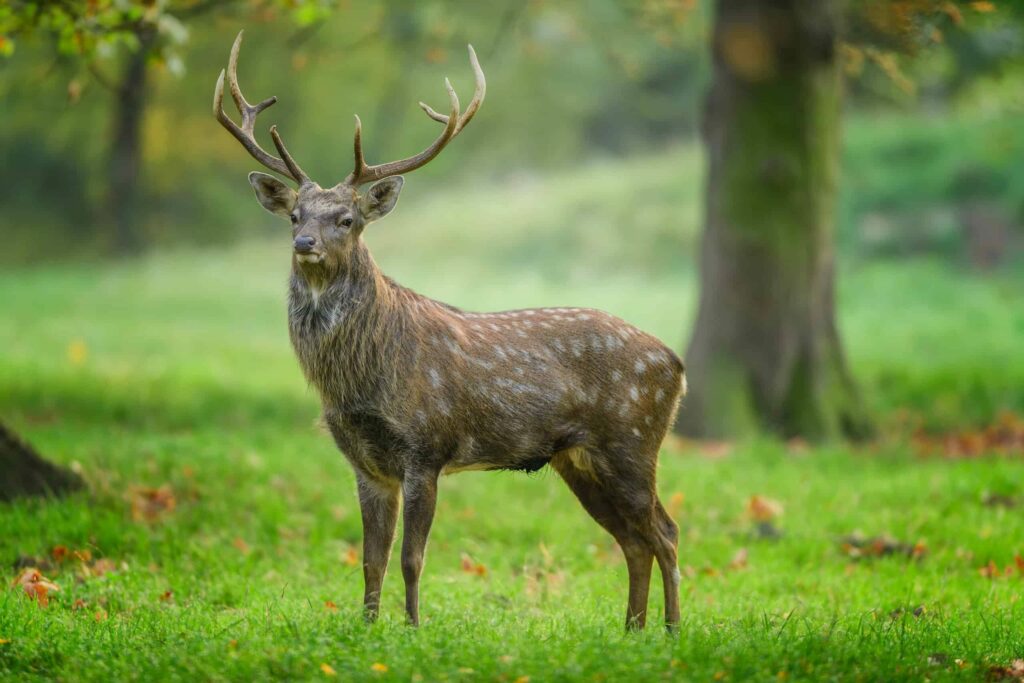Sika deer, scientifically known as Cervus nippon, are captivating creatures that grace the woodlands with their presence. With a unique set of characteristics and a storied history, these deer have managed to capture the imagination of wildlife enthusiasts worldwide. In this comprehensive article, we delve into the world of sika deer, exploring their taxonomy, habitat, behaviour, conservation status, and more. Join us on this in-depth journey as we unravel the mysteries surrounding these remarkable animals.
Overview of Sika Deer
Sika deer, also commonly referred to as “sika,” are medium-sized deer native to East Asia. They belong to the Cervidae family and the genus Cervus, which includes other deer species such as red deer and elk. Sika deer have a rich cultural significance in East Asian countries and have been introduced to various parts of the world, including the United States, Europe, and New Zealand.
Taxonomy and Classification
Sika deer belong to the species Cervus nippon, and they are further classified into several subspecies, each with its own unique characteristics and distribution. These subspecies include the Japanese sika deer (Cervus nippon nippon), the Manchurian sika deer (Cervus nippon mantchuricus), and the Formosan sika deer (Cervus nippon taiouanus), among others. The taxonomy and classification of sika deer help us understand their evolutionary history and genetic diversity.

Habitat and Distribution
Sika deer are adaptable creatures that can thrive in diverse habitats. In their native range, they inhabit a variety of environments, including deciduous broadleaf forests, coniferous forests, and grasslands. They have a wide distribution across East Asia, including countries such as Japan, China, Korea, and Taiwan. Due to human intervention and intentional introductions, sika deer have established populations in different parts of the world, such as the UK, often adapting to new habitats.
Physical Characteristics
One of the defining features of sika deer is their striking coat patterns. Depending on the subspecies, their fur can range from reddish-brown to dark brown, with distinct white spots that gradually fade as they grow older. This unique colouration provides effective camouflage in their natural habitats. Sika deer have a slender and agile body, with a shoulder height ranging from about 60 to 110 centimetres (24 to 43 inches). They possess short tails and impressive antlers that vary in size and shape among males. The antlers are deciduous and are shed and regrown annually.
Behaviour and Social Structure
Sika deer exhibit a complex social structure characterised by different groups. Females and their young form cohesive herds, while adult males are typically solitary or form small bachelor groups. During the breeding season, known as the rut, dominant males engage in fierce battles for mating rights. The rut is a period of intense vocalisations and physical displays, with males emitting a variety of calls to attract females and ward off competitors. The social behaviour of sika deer adds to the dramatic spectacle of their mating rituals.

Diet and Feeding Habits
Sika deer are primarily herbivorous, feeding on a wide variety of vegetation. Their diet includes grasses, leaves, shoots, fruits, and even tree bark. They are selective browsers and adapt their feeding habits based on the availability of food sources in their habitats. Sika deer play an important role in seed dispersal, aiding in the regeneration and biodiversity of the ecosystems they inhabit.
Reproduction and Life Cycle
The reproductive cycle of sika deer is a captivating process. Breeding occurs during the rut, when males compete for mating rights. The dominant male defends a harem of females, ensuring his genetic success. After a gestation period of around eight months, females give birth to a single fawn, although twins can occur occasionally. The young deer, known as calves, are born with white spots to provide additional camouflage. They grow rapidly under the care of their mothers and gain independence within a year.
Conservation Status
While sika deer populations are relatively stable in their native range, they face various conservation challenges in areas where they have been introduced. Habitat loss, competition with other species, overhunting, and the potential transmission of diseases pose threats to their survival. Conservation initiatives aim to strike a balance between managing their impact as an invasive species and preserving their ecological significance in both native and introduced habitats.

Interactions with Humans
Sika deer have a complex relationship with humans. In their native regions, they have cultural and symbolic significance, often appearing in folklore, art, and traditional ceremonies. However, conflicts arise when their populations grow beyond sustainable levels, leading to damage in agricultural fields, forests, and gardens. Finding solutions that mitigate these conflicts is crucial for ensuring harmonious coexistence between sika deer and human communities.
Sika Deer as an Invasive Species
The introduction of sika deer to new environments has presented unique challenges. In certain areas where they have been introduced, they have become invasive, negatively impacting native flora and fauna. Their browsing habits can alter plant composition and affect the natural balance of ecosystems. Understanding the ecological consequences of their presence and implementing effective management strategies is essential to mitigate their invasive tendencies and preserve local biodiversity.
Management and Control Measures
Efforts to manage sika deer populations include various strategies such as habitat modification, population control through culling or regulated hunting, and the use of exclusion fencing. These measures aim to address the ecological and economic impacts caused by their presence while ensuring the long-term sustainability of native ecosystems. Collaboration between wildlife managers, researchers, and local communities is crucial for implementing effective management and control measures.
Hunting and Wildlife Management
Sika deer hunting has gained popularity among hunters, as they provide a challenging and rewarding experience. Responsible hunting practices, coupled with wildlife management programs, contribute to population control and conservation efforts. Hunting regulations and guidelines help maintain sustainable hunting practices while preserving the integrity of the species and their habitats. Proper wildlife management ensures the long-term viability of sika deer populations.
Cultural Significance
Sika deer hold cultural significance in various East Asian countries. They are often depicted in art, literature, and traditional ceremonies, symbolising qualities such as beauty, grace, and resilience. The presence of sika deer in folklore and cultural practices showcases the deep connection between humans and nature, highlighting the importance of conserving these magnificent creatures.
Interesting Facts about Sika Deer
- Sika deer are known for their distinctive whistling alarm call, which they use to alert others of potential dangers.
- They are excellent swimmers and can traverse bodies of water with ease.
- Sika deer have played a significant role in shaping the cultural heritage of East Asian countries.
- Some subspecies of sika deer have adapted to colder climates, growing a thicker winter coat to withstand harsh weather conditions.
- Sika deer are highly adaptable and can thrive in both natural and human-altered landscapes.
Conclusion
In conclusion, sika deer are captivating creatures that offer a glimpse into the beauty and complexity of the natural world. From their habitat preferences to their social behaviours and the challenges they face as an invasive species, these deer inspire awe and fascination. By understanding their ecological role and implementing effective conservation measures, we can ensure the continued existence of sika deer and appreciate the unique contributions they make to our ecosystems.
Additional Resources
Sources and References
- Groves, C. (1981). Systematics of the Sika Deer and implications for conservation. Acta Theriologica, 26(20), 307-316.
- Harris, R. B., & Sawada, H. (2002). Sika deer. In S. Harris, & J. W. Duckworth (Eds.), Deer of the World: Their Evolution, Behavior, and Ecology
Sam loves to learn about animals and their habitats. He has been a nature lover from a very young age, and has been writing papers and articles about wildlife for as long as he can remember.
